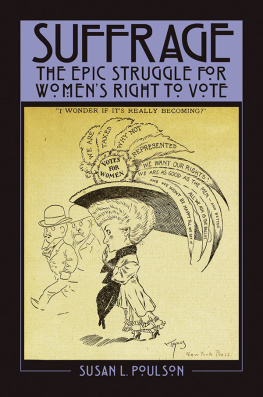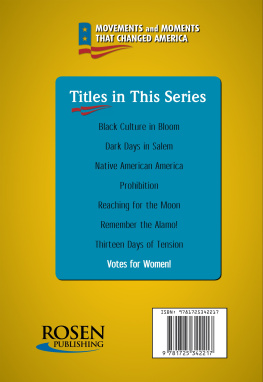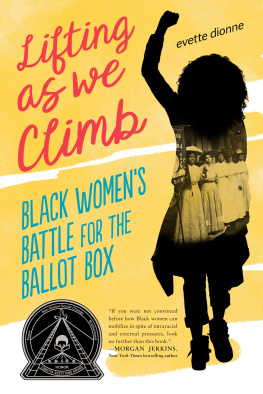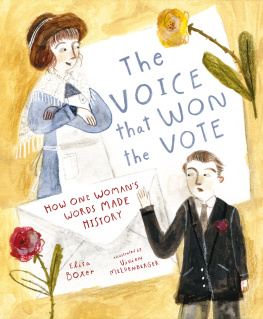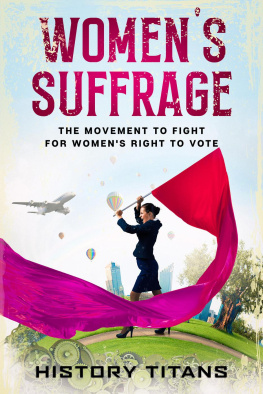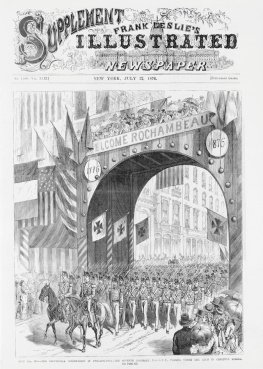Susan L. Poulson - Suffrage: The Epic Struggle for Womens Right to Vote
Here you can read online Susan L. Poulson - Suffrage: The Epic Struggle for Womens Right to Vote full text of the book (entire story) in english for free. Download pdf and epub, get meaning, cover and reviews about this ebook. year: 2020, publisher: ABC-CLIO, genre: Non-fiction. Description of the work, (preface) as well as reviews are available. Best literature library LitArk.com created for fans of good reading and offers a wide selection of genres:
Romance novel
Science fiction
Adventure
Detective
Science
History
Home and family
Prose
Art
Politics
Computer
Non-fiction
Religion
Business
Children
Humor
Choose a favorite category and find really read worthwhile books. Enjoy immersion in the world of imagination, feel the emotions of the characters or learn something new for yourself, make an fascinating discovery.
- Book:Suffrage: The Epic Struggle for Womens Right to Vote
- Author:
- Publisher:ABC-CLIO
- Genre:
- Year:2020
- Rating:5 / 5
- Favourites:Add to favourites
- Your mark:
- 100
- 1
- 2
- 3
- 4
- 5
Suffrage: The Epic Struggle for Womens Right to Vote: summary, description and annotation
We offer to read an annotation, description, summary or preface (depends on what the author of the book "Suffrage: The Epic Struggle for Womens Right to Vote" wrote himself). If you haven't found the necessary information about the book — write in the comments, we will try to find it.
Suffrage: The Epic Struggle for Womens Right to Vote — read online for free the complete book (whole text) full work
Below is the text of the book, divided by pages. System saving the place of the last page read, allows you to conveniently read the book "Suffrage: The Epic Struggle for Womens Right to Vote" online for free, without having to search again every time where you left off. Put a bookmark, and you can go to the page where you finished reading at any time.
Font size:
Interval:
Bookmark:

Suffrage
The Epic Struggle for Women's Right to Vote
Susan L. Poulson

Copyright 2019 by Susan L. Poulson
All rights reserved. No part of this publication may be reproduced, stored in a retrieval system, or transmitted, in any form or by any means, electronic, mechanical, photocopying, recording, or otherwise, except for the inclusion of brief quotations in a review, without prior permission in writing from the publisher.
Library of Congress Control Number: 2019020663
ISBN: 978-1-4408-6788-0 (print)
978-1-4408-6789-7 (ebook)
23 22 21 20 19 1 2 3 4 5
This book is also available as an eBook.
Praeger
An Imprint of ABC-CLIO, LLC
ABC-CLIO, LLC
147 Castilian Drive
Santa Barbara, California 93117
www.abc-clio.com
This book is printed on acid-free paper 
Manufactured in the United States of America
For Bobby, Laura & Julia
Carrie Chapman Catt
Carrie Chapman Catt to Alice Stone Blackwell, September 13, 1943, Catt Papers, Library of Congress, 4, in Robert Booth Fowler, Carrie Catt: Feminist Politician (Boston: Northeastern, 1988), 155.
| AB | Alva Belmont |
| ABB | Antoinette Btrn Blackwell |
| AHS | Anna Howard Shaw |
| AP | Alice Paul |
| ASB | Alice Stone Blackwell |
| CCC | Carrie Chapman Catt |
| HBB | Henry Btrne Blackwell |
| HBS | Henry Brewster Stanton |
| IBH | Isabella Beecher Hooker |
| LS | Lucy Stone |
| SBA | Susan B. Anthony |
| ST | Sojourner Truth |
| WLG | William Lloyd Garrison |
| AERA | American Equal Rights Association |
| AWSA | American Woman Suffrage Association |
| ICW | International Council of Women |
| IWSA | International Woman Suffrage Alliance |
| NAOWS | National Association Opposed to Woman Suffrage |
| NAWSA | National American Woman Suffrage Association |
| NWP | National Womans Party |
| NWSA | National Woman Suffrage Association |
| WESA | Washington Equal Suffrage Association |
| WPU | Womens Political Union |
| WSP | Woman Suffrage Party |
| WTUL | Womens Trade Union League |
| LC | Library of Congress |
| SCA | Smith College Archives |
| SL | Schlesinger Archives |
| TUL | Tulane University Library |
| UKSC | University of Kentucky Special Collections |
| VCA | Vassar College Archives |
| BSC | Belmont Suffrage Clippings |
| HWS | History of Woman Suffrage |
| SBA | Life and Work of Susan B. Anthony |
| SBASB | Susan B. Anthony Scrapbooks |
| SP | Selected Papers of Elizabeth Cady Stanton & Susan B. Anthony |
Awakening
On a summerlike day in May 1840, a young couple climbed aboard the Montreal in New York Harbor for their honeymoon voyage to the United Kingdom. The Montreal was a packet ship, a 542-ton workhorse that plied the Atlantic six times a year between the busy ports of England and New York. Its three masts, each bearing triplets of giant sails and miles of line rigged along the crossbars, towered above the deck as the crew loaded the hold below. Captain Seth Griffing and his first mate made their final preparations as passengers bade farewell to family and friends. The bride raced her brother-in-law around the ship in a last-minute game of tag, her wavy chestnut hair bouncing as she ran. I had a desperate chase after him all over the vessel, but in vain, she later recalled. The game made them laugh and eased the pain of separation. The bride and groom would be gone for seven months.
Travel to Europe would become a well-worn path for many American newlyweds eager to see the cultural tapestry of the Old World, but this couple was different. Henry and Elizabeth Cady Stanton were embarking on a mission to confront the greatest moral evil of the ageslavery. Over the next several years, as Elizabeth would observe the struggle to liberate slaves, and awaken to her own subordination, slowly, tentatively, and with a good dose of self-doubt, she would join others to confront the laws and traditions that restricted womennorms embedded so deeply in American life that they seemed like common sense. But first she had to imagine a different world.
The Stantons had married after a whirlwind courtship. Elizabeth was a Cadythe most prominent family in Johnstown, New York, a prosperous town a days ride northwest of Albany. Her mother Margaret was an American aristocrat, the tall, refined daughter of Colonel James Livingston, a Revolutionary War hero who had thwarted Benedict Arnolds attempt to deliver West Point to the British. Elizabeth admired her mother, Her father Daniel had risen from humble beginnings to become a well-respected judge who dabbled in politics, serving for years in the New York State Legislature and a single term in the U.S. House of Representatives.
The Cadys lived in a stately home at the edge of the main square, a short walk from the Fulton County Courthouse where Judge Cady presided. It was a bustling household, with eleven children, several servants, and a slave, Peter Teabout, before New York ended slavery in the late 1820s. Elizabeth liked to play outdoors with her younger sister Margaret in the stream that ran through the center of town and to build snow forts in winter. She delighted in small acts of defiance, sneaking into the garret with her sister to nibble on stores of hickory nuts and maple sugar cakes. Her parents, she later recalled, were as kind, indulgent, and considerate as the Puritan ideas of those days permitted, but there was more fear than love, and she had a confused memory of being often under punishment. The Cady children were well educated, first in Johnstown schools, then college for the boys, and for Elizabeth, the Troy Female Seminary, which was an early higher education institution for women founded in 1814 by Emma Willard. There, Elizabeth received the message often delivered in womens higher education in the mid-nineteenth centurythat women could be educated in traditionally male subjects such as logic, mathematics, and criticism, along with subjects like domestic science, sketching, and singing, all to become respectable wives and mothers. Elizabeth would learn to view her world critically and see the man-made roots of accepted institutions, but would have few outlets for action.
After graduating at seventeen, Elizabeth enjoyed the next six years in the suspended existence of a well-educated young woman. She read widely on the new trends of phrenology and homeopathic medicine as well as the romantic poems and novels of Lord Byron, Samuel Taylor Coleridge, and Sir Walter Scott. She discussed legal matters with her father and brother-in-law and traveled the state of New York to visit family and friends. She was slender and pretty, and took pride in dressing well. She sang while playing piano and guitar and enjoyed balls, dances, and hayrides. She was witty and irreverent with a penchant for practical jokes. When a suitor once challenged her to remain silent during an entire carriage ride, she fashioned a dummy out of straw, wrapped it in her coat and hat, placed it in the carriage, and sent him off. By twenty-three, most women her age had married and produced children, but Elizabeth enjoyed her independence and was in no rush to wed.
Font size:
Interval:
Bookmark:
Similar books «Suffrage: The Epic Struggle for Womens Right to Vote»
Look at similar books to Suffrage: The Epic Struggle for Womens Right to Vote. We have selected literature similar in name and meaning in the hope of providing readers with more options to find new, interesting, not yet read works.
Discussion, reviews of the book Suffrage: The Epic Struggle for Womens Right to Vote and just readers' own opinions. Leave your comments, write what you think about the work, its meaning or the main characters. Specify what exactly you liked and what you didn't like, and why you think so.

